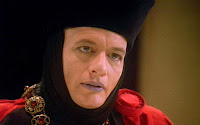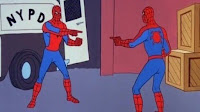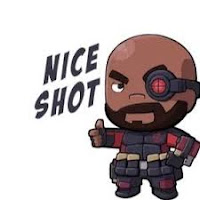Anyway…
Welcome to the first of what will hopefully be an amazing and not-too-rambly twelve part series about book writing. Well, really this is going to be about how to tell a story. So these concepts we’re talking about are going to apply across a lot of different storytelling formats.
Why am I calling it A2Q? Well, first off it makes me look all hip, swapping in the 2 instead of to. Second, it’s because we’ve all heard A to Z so many times our eyes slide right past it, while you’ll remember A to Q because it’s weird sounding and absurd. I mean, the last time Q was even remotely worth paying attention to was back when John DeLancie played him. Everything since then’s been utter nonsense. So we’re taking Q back, people!
Also, I’m starting this off with the idea that all of us are working with the same basic tools here. I’m not going to talk much about vocabulary, spelling, grammar, or any of that (though they may come up a bit somewhere down the road). Nobody’s going to fault me because I didn’t bring a conduit bender to the job site, but if I don’t even have a hammer and a pair of pliers in my toolbag… well, maybe I’m not ready for this quite yet.
Also-also, from this point on in the series, I’m probably going to be saying bookand novel a lot here. Like I mentioned above, the basic storytelling ideas we’re going to be talking about can apply to a lot of different formats—books, short stories, comics, movies, and more. But for this discussion, story is going to mean something very specific, and I don’t want things to get confusing. So book or novel is going to refer to our overall manuscript, while story is going to refer to… well, we’ll get into that in part four.
It’s also worth mentioning that ideas are super common. Like, so common they’re pretty much worthless. They’re like rocks. It’s really important to understand this, because that understanding’s going to let us take our first big step.
This causes problems for all of us when we’re starting out because we want good ideas. We want that $50,000 advance and the Nobel for literature, so our ideas have to be the best ones we can think of. No half-baked, crappy ideas for us, right?
Except… that’s how all ideas start out—as half-baked, crappy blobs. An analogy I’ve used before is diamonds. In their natural state, they’re crusty, dark, lumpy things. It’s only after lots of cutting and shaping and polishing that we end up with what we think of as a diamond. Over the years, I’ve noticed when most people sit down to start writing (physically or metaphorically) they do one of two things when they encounter these idea-diamonds.
One group of aspiring writers—the larger group, I think—finds those crusty idea-lumps and gets frustrated that they’re only finding… well, lumps. We end up tossing them aside to look for the good ideas. We want to find the shining, sparkling thing that everyone immediately is going to recognize as a brilliant idea.
This is really the same misconception seen from two different sides. One group’s assuming the idea isn’t any good, so they’re just leaving it on the ground. The other group’s assuming the idea must be good just because they picked it up. But really, whichever group I’m in, I’m ignoring the fact that ideas need work before they’re worth anything. I’m going to have to look at them, weigh them, and consider them from a bunch of angles. Maybe even make a few preliminary cuts and shine it up a little, just to get a good sense of themWith me so far? I know, the diamond analogy wobbled a bit in there. Hang on, I’m going to use it for a few more paragraphs.
But a lot of it—for writers at every level—is just sitting down and working with the ideas
On a related note, we also want to keep in mind that at this very fine, granular level, a lot of ideas are going to look similar. An idea is probably the basic building block of any book, and a lot of basics are similar. One brick looks a lot like every other brick. This cup of flour looks a lot like that one. I shouldn’t freak out if somebody has already thought of “they’re all clones” or “high school outcast dates the cheerleader” or “they were dead the whole time.” Some of you may remember the tale of how John Scalzi and I once both came up with the same basic idea at the same time, but the way we used it and connected it to other ideas was pretty different.
Next time for A2Q, probably week after next, I’m going to talk about how we take a couple of these ideas and line them up into a plot.
Next time here on the ranty blog, I wanted to talk about where the action is.
Until then… go write.















